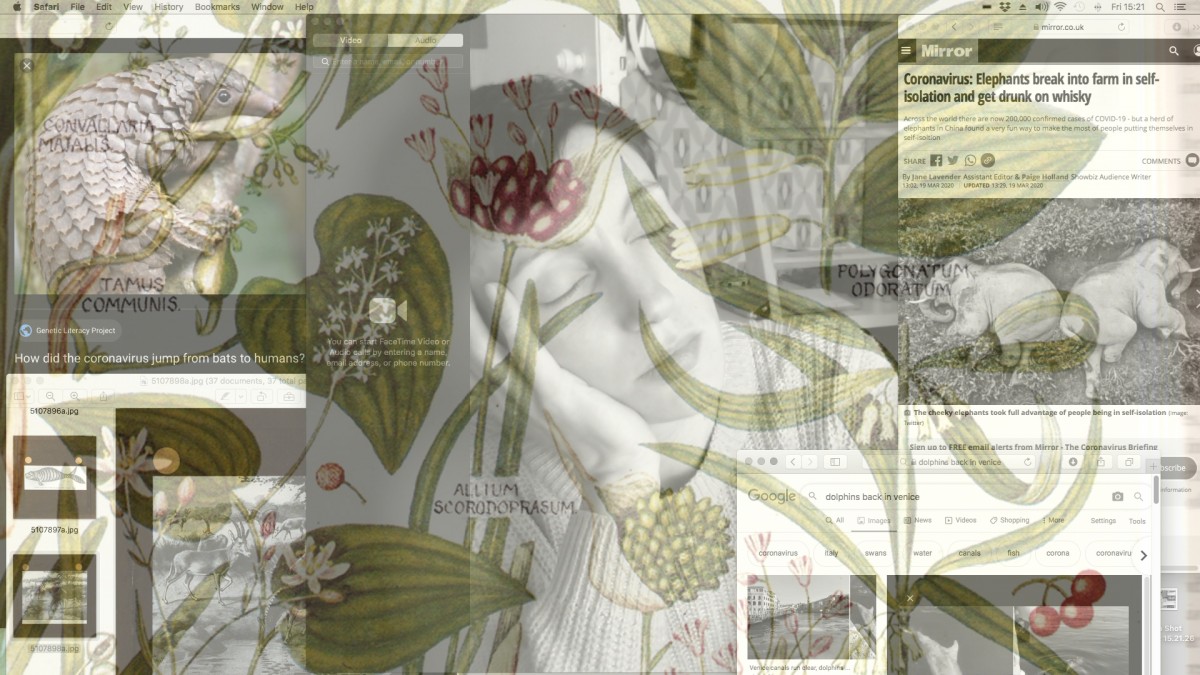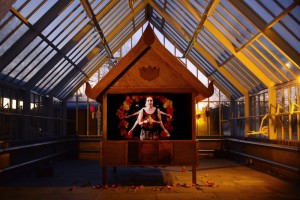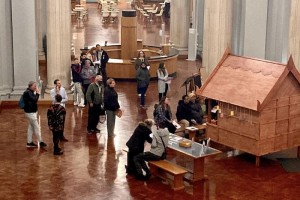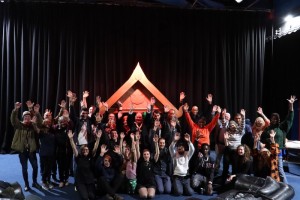The coronavirus pandemic presents difficulties for the ‘Thinking Through Extinction’ project. It also raises profound questions about human and nonhuman extinction.
COVID-19 is radically reshaping the world. So too is it reshaping the ‘Thinking Through Extinction’ project. As I write today, the project is six months old. Through conversations with the project’s partners at Manchester Museum, collaborations with our artist in residence, Laurence Payot, and research into heritage, museums and extinction, we have come to identify ‘public’ as one of the project’s prevailing keywords.
Extinction, we argue, is increasingly being made public. Extinction is being charged with a new urgency by the cascading effects of climate collapse. It is being debated in parliaments. It is being mobilised by street movements such as Extinction Rebellion and Ende Gelände. It is being theorised by disciplines including the environmental humanities and multispecies studies. Museums around the world, aware of their unique position as public educators, have been developing new curatorial and heritage practices in order to exhibit the sixth extinction.
And yet it is not clear that this word, ‘extinction’, means the same thing to different publics. For some people, extinction provokes an apocalyptic image of the end of humanity. For others, extinction signifies the slow passing of charismatic nonhuman animals such as Lonesome George, the last Pinta Island tortoise.
For this reason, we developed the formulation ‘Extinction in Public’ in order to concentrate our discussions around this word, extinction, as it becomes an emergent keyword of public life, and to investigate what’s at stake in extinction’s many contradictory and overlapping meanings. We want to ask critical questions: What is at stake in making public the Sixth Mass Extinction Event? Which publics are engaging with extinction? And if extinction means different things to different people, then how do contemporary exhibitions address these different, even competing valences?
To interrogate these questions, and to develop ideas collaboratively with other scholars, we organised a symposium, scheduled for October 2020. By hosting the symposium in Manchester Museum, a museum that is thinking through its own role in communicating extinction to different audiences, we set out to question the relationship between public institutions, public participation and anthropogenic extinctions. The project’s overarching aim, then, is to open up new ways of thinking extinction in the museum space.
But the COVID-19 pandemic presents serious difficulties for all of this. Public institutions like Manchester Museum are now closed indefinitely. Transport, both within and between nations, is now greatly reduced if not suspended completely. Our artist in residence, Laurence Payot, will no longer be able to hold the creative workshops she needed in order to start work on a hologram about the sixth extinction. Depending on how the pandemic is managed in the weeks ahead, life may well be put on pause until Spring 2021.
What happens, then, to a project that explores extinction in public when public space themselves are closed? Do digital technologies offer new spaces for public engagements with extinction? And how must the ‘Thinking Through Extinction’ project adapt to our own adapted living and working conditions?
While we regroup as a team to consider how to pause, adapt or transform the project in the coming months, we must also make time to think carefully about the profound questions that the coronavirus pandemic raises about extinction. COVID-19’s mortality rate is thought to be between 3-4%. But still it raises the spectres of both the possible extinction of the human species and of the ongoing sixth mass extinction of the earth’s wildlife.
On the one side, COVID-19 has intensified contemporary anxieties pertaining to human extinction. The virus has quickly exposed the entrenched inequities in our society, it has revealed the fragility of the real economy under global neoliberalism, and in doing so it has generated existential questions about the future of humanity: who gets to survive? How might society be organised differently, both now and in the future? Social networks are full of memes about the end of humanity. Steven Soderberg’s 2011 pandemic thriller Contagion, uncannily prescient in its systemic depiction of disease spread, is being revisited by viewers the world over. Board games like Pandemic and Virus are enjoying spikes in sales. We are all, to a greater or lesser extent, collectively engaging with what Chritos Lynteris has called the ‘pandemic imaginary’ – we are searching for works which not only echo or refract our present, but also equip us with the preparedness to face it. The virus, like climate change, unsettles the fantasy of human invincibility. As George Monbiot has argued, coronavirus shows us that despite how alienated we are from nature, we are still biological beings, ‘dependent on a habitable planet’.
On the other side, the virus has further revealed the nature of human-animal relations in the twenty-first century. Last week, many of us were caught off guard by fake stories about animals supposedly returning to and flourishing in quarantined cities. Swans and dolphins were claimed to have returned to Venice’s canals. Elephants in Yunnan, China, were said to have slept peacefully in a tea garden. ‘I think people really want to believe in the power of nature to recover’, suggests Susan Clayton, a professor of psychology and environmental studies. COVID-19 will likely generate many more myths about nature’s supposed ‘recovery’.
Yet the reality is that the story of coronavirus is also the story of nature’s decline. In fact, one cannot talk about the coronavirus pandemic without also talking about the mass extinction and mass production of animals. In an illuminating article, Thom van Dooren reminds us that the endangered pangolin species, thought of by many scientists as the most likely source of the virus, is the most trafficked wild animal on the planet. Thus ‘the pandemic that we are currently facing is a symptom of a much larger problem’, van Dooren writes. ‘It emerges out of an increasingly dysfunctional relationship between human communities, other animals, and the broader environment’. As habitats shrink due to deforestation and infrastructural projects, animals become increasingly crowded together, and come into more and more sustained contact with humans. Sonia Shah, writing in The Nation, puts this most sharply: the widespread speculation about which wild creature harbored the virus – a pangolin? A bat? A snake? – ultimately ‘obscures a more fundamental source of our growing vulnerability to pandemics: the accelerating pace of habitat loss’.
Authors such as David Quammen, Mike Davis and Rob Wallace have each convincingly shown how zoonotic diseases derive from the increasing destruction of biodiversity and concentrated animal farming programmes. Wallace, speaking in a recent interview about the pandemic, writes that ‘the capital-led agriculture that replaces more natural ecologies offers the exact means by which pathogens can evolve the most virulent and infectious phenotypes. You couldn’t design a better system to breed deadly diseases’.
Thus although coronavirus is zoonotic, and while its origins are undoubtedly animal, the virus also derives from a dangerous combination: staggering levels of habitat loss, and an equally staggering intensification of industrialised agricultural practices. ‘A number of researchers today think that it is actually humanity’s destruction of biodiversity that creates the conditions for new viruses and diseases such as Covid-19’, John Vidal writes in the Guardian.
COVID-19 therefore begins with the Sixth Mass Extinction Event. It begins, as we have seen, with major habitat loss due to deforestation and encroachment. But the virus may well end with the sixth extinction, too. A recent article in Nature warns that great apes, already endangered, risk being infected with the disease if governments, conservation practitioners, researchers, tourism professionals and funding agencies do not act quickly to reduce the risk of introducing the virus into endangered species populations.
Reading this, it’s hard not to feel an acute sense of shock at the potential forms and pathways of transmission that connect the virus to species extinctions. It shows us that the idea of public health, as a system of promotion, prevention and protection, raises the question of our obligation to each other, including our endangered animal others with whom we share the planet.
It’s in the interest of public health that public spaces are now shut. We do not yet know what this means for our project. But the irony is not lost on us that we are now developing a public-facing project that is, in effect, closed to the public.
There will, of course, be other virtual ways to engage the public, and to at once raise and scrutinise the problem of extinction with fellow scholars. Our artist in residence is already developing new ideas for how to create artworks under conditions of isolation. The haunting image that accompanies this article is Laurence’s visual response to this blog, utilising the aesthetics of the desktop screen in order to visualise the cacophony of news articles about nature during the past fortnight.
Whatever uncertainty lies ahead, I find guidance in the feminist art historian Griselda Pollock’s work on the ‘virtual feminist museum’. When Pollock speaks of the virtual feminist museum, she is thinking not of a digital reproduction of a museum, gallery or exhibition. In fact, the ‘virtual’ in this formulation qualifies the word ‘feminism’ rather than ‘museum’. Feminism is virtual because the struggle for emancipation is forever incomplete. Feminism is always becoming-feminism.
In a similar vein, we can ask: what would it mean for museums to actually reinvent, rather than digitally reproduce, their representations of extinction? How does a museum’s physical closure also generate new opportunities for engaging different publics? What is the future of natural history collections in a time of climate collapse and mass extinction?





